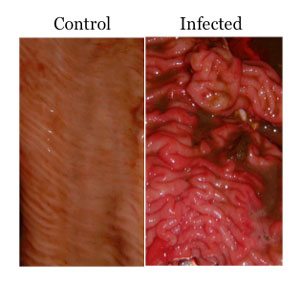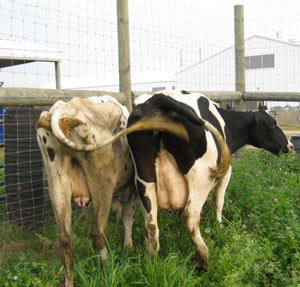New grant aims to help control deadly dairy cattle disease
A Michigan State University (MSU) AgBioResearch animal scientist is among a group of researchers who have received a $3 million grant from the U.S. Department of Agriculture National Institute of Food and Agriculture.
 A Michigan State University (MSU) AgBioResearch animal scientist is among a group of researchers who have received a $3 million grant from the U.S. Department of Agriculture National Institute of Food and Agriculture (USDA NIFA) through its Translational Genomics Program to study the genetic basis of resistance or susceptibility to Johne’s disease over the next five years.
A Michigan State University (MSU) AgBioResearch animal scientist is among a group of researchers who have received a $3 million grant from the U.S. Department of Agriculture National Institute of Food and Agriculture (USDA NIFA) through its Translational Genomics Program to study the genetic basis of resistance or susceptibility to Johne’s disease over the next five years.
Johne’s disease is a contagious, untreatable and fatal gastrointestinal disease of domesticated ruminant livestock. It ranks as one of the most costly infectious diseases of dairy cattle, affecting 65 percent of U.S. dairies.
“Our long-term objective is to use the tools of modern genetics and immunology to understand why only some cattle get sick following infection with Mycobacterium avium subspecies paratuberculosis (MAP), the causative agent of Johne’s disease, and to determine if it is possible to breed cattle that are more resistant to the devastating effects of clinical Johne’s disease,” said Paul Coussens, a professor in the MSU departments of Animal Science and Microbiology and Molecular Genetics and director of the MSU Molecular Pathogenesis Laboratory.
He is working on the project with C. Titus Brown, an assistant professor in the MSU departments of Computer Science and Engineering, and Microbiology and Molecular Genetics; and Brian W. Kirkpatrick, an animal sciences professor at the University of Wisconsin-Madison.
The slow, progressive nature of Johne’s disease makes diagnosis difficult, especially during the early preclinical stages. There are no cost-effective therapies, and vaccines – which aren’t used in the United States – do not prevent infections or stop the spread of the disease to other animals. In addition, there may be a link between Johne’s disease and Crohn’s disease, an incurable inflammatory intestinal disorder affecting humans.
MSU has a long history of working both in the basic science of the organism causing Johne’s disease and the host response to it, as well as research on control programs to help producers deal with Johne’s disease.
This particular project has several aspects.
“First and foremost, the new Translational Genomics Program from USDA NIFA allows us enough time and funds to track animals over a long period of time. This is critical in research on Johne’s disease because the disease can take two to five years to develop following initial infection,” said Coussens, who has worked on Johne’s disease research for more than a decade.
He is also one of the founding members of the Johne’s Disease Integrated Program, a collaboration of more than 80 universities and the USDA working to develop solutions and mitigate losses associated with Johne’s disease.
 During the first and second years of the project, the researchers hope to determine the genetic makeup of each of the animals in the study and monitor the progress of each animal in a producer setting in commercial herds. Most of the research will be completed on dairy herds in Michigan.
During the first and second years of the project, the researchers hope to determine the genetic makeup of each of the animals in the study and monitor the progress of each animal in a producer setting in commercial herds. Most of the research will be completed on dairy herds in Michigan.
“The goal is to be able to identify animals very early on that have a high probability of being resistant to the infection to begin with,” Coussens said.
The second part of the research will involve tracking young calves over four years as they enter herds known to be contaminated with paratuberculosis to examine what type of immune response they have when exposed, and to track whether they become sick with the disease.
“Generally all these calves will be exposed, but only a small percent will develop the disease, so we believe that the genetics to properly control the infection and be resistant to the disease are already in our herds,” Coussens said. “We just never looked for them before. It’s a new way of thinking about this disease and how to control it.”
The project is made possible with the tools of modern-day genetics.
“The money that has been spent through USDA on genome sequencing of bovines is a tremendous help,” he said. “This new research would not be possible without that. In addition, the investment that MSU and AgBioResearch have made in state-of-the-art genetic technologies on campus also enables us. We would not be able to do it without that infrastructure.”
Investments in people are also a factor.
“Titus [C. Titus Brown] is an expert in bioinformatics. We could not handle the large amount of data involved in this project, and the associations between the genetics and the immune response and the disease would be impossible without investments in people like Titus and in equipment to supply the large amount of computing power needed for this project,” Coussens said.
He hopes that the work will enhance knowledge of basic immune responses in cattle and be useful in many diseases in cattle and possibly in humans.
“Our ultimate objective is to work with dairy producers and breeders to ensure that our results are used in the industry to breed cattle that are resistant to Johne’s disease and thereby improve profitability, animal welfare and the overall safety of our food supply,” Coussens said.
MSU AgBioResearch engages in innovative, leading-edge research that combines scientific expertise with practical experience to generate economic prosperity, sustain natural resources, and enhance the quality of life in Michigan, the nation and the world. It encompasses the work of more than 300 scientists in six MSU colleges – Agriculture and Natural Resources, Communication Arts and Sciences, Engineering, Natural Science, Social Science and Veterinary Medicine – and has a network of 13 research centers across the state.



 Print
Print Email
Email





